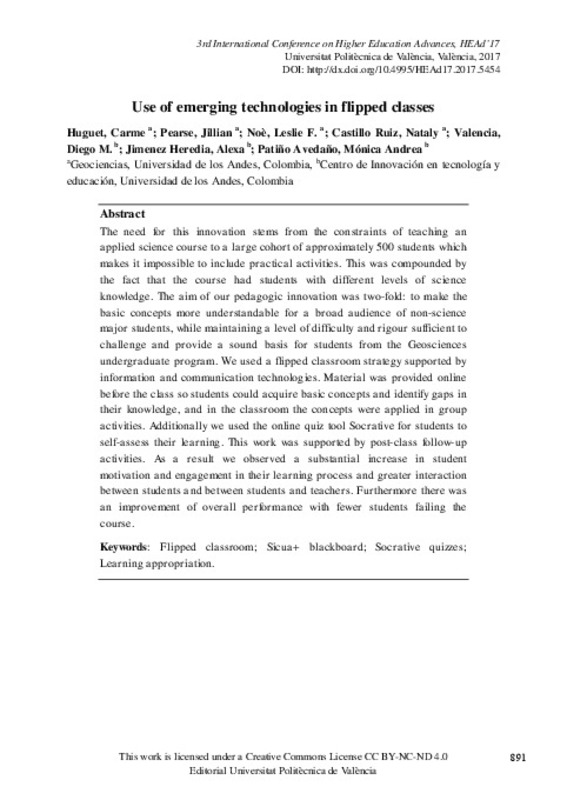JavaScript is disabled for your browser. Some features of this site may not work without it.
Buscar en RiuNet
Listar
Mi cuenta
Estadísticas
Ayuda RiuNet
Admin. UPV
Use of emerging technologies in flipped classes
Mostrar el registro sencillo del ítem
Ficheros en el ítem
| dc.contributor.author | Huguet, Carme
|
es_ES |
| dc.contributor.author | Pearse, Jillian
|
es_ES |
| dc.contributor.author | Noè, Leslie F.
|
es_ES |
| dc.contributor.author | Castillo Ruiz, Nataly
|
es_ES |
| dc.contributor.author | Valencia, Diego
|
es_ES |
| dc.contributor.author | Jimenez Heredia, Alexa
|
es_ES |
| dc.contributor.author | Patiño Avedaño, Mónica Andrea
|
es_ES |
| dc.date.accessioned | 2018-06-27T07:09:19Z | |
| dc.date.available | 2018-06-27T07:09:19Z | |
| dc.date.issued | 2017-06-26 | |
| dc.identifier.isbn | 9788490485903 | |
| dc.identifier.uri | http://hdl.handle.net/10251/104670 | |
| dc.description.abstract | [EN] The need for this innovation stems from the constraints of teaching an applied science course to a large cohort of approximately 500 students which makes it impossible to include practical activities. This was compounded by the fact that the course had students with different levels of science knowledge. The aim of our pedagogic innovation was two-fold: to make the basic concepts more understandable for a broad audience of non-science major students; and to maintain a level of difficulty and rigour sufficient to challenge and provide a sound basis for students from the Geosciences undergraduate program. We used a flipped classroom strategy supported by the use of information and communication technologies. Material was provided online before the class so students could aquire basic concepts and identify gaps in their knowledge, and in the classroom the concepts were applied in group activities. Additionally we used the online quiz tool Socrative for students to self-assess their learning. This work was supported by post-class follow-up activities. As a result we observed a substantial increased in student motivation and engagement in their learning process and greater interaction between students and between students and teachers. Furthermore there was an improvement of overall performance with fever students failing the course | es_ES |
| dc.format.extent | 8 | es_ES |
| dc.language | Inglés | es_ES |
| dc.publisher | Editorial Universitat Politècnica de València | es_ES |
| dc.relation.ispartof | Proceedings of the 3rd International Conference on Higher Education Advances | es_ES |
| dc.rights | Reconocimiento - No comercial - Sin obra derivada (by-nc-nd) | es_ES |
| dc.subject | Higher Education | es_ES |
| dc.subject | Learning | es_ES |
| dc.subject | Educational systems | es_ES |
| dc.subject | Teaching | es_ES |
| dc.subject | Flipped classroom | es_ES |
| dc.subject | Sicua+ blackboard | es_ES |
| dc.subject | Socrative quizzes | es_ES |
| dc.subject | Learning appropriation | es_ES |
| dc.title | Use of emerging technologies in flipped classes | es_ES |
| dc.type | Capítulo de libro | es_ES |
| dc.type | Comunicación en congreso | es_ES |
| dc.identifier.doi | 10.4995/HEAD17.2017.5454 | |
| dc.rights.accessRights | Abierto | es_ES |
| dc.description.bibliographicCitation | Huguet, C.; Pearse, J.; Noè, LF.; Castillo Ruiz, N.; Valencia, D.; Jimenez Heredia, A.; Patiño Avedaño, MA. (2017). Use of emerging technologies in flipped classes. En Proceedings of the 3rd International Conference on Higher Education Advances. Editorial Universitat Politècnica de València. 891-898. https://doi.org/10.4995/HEAD17.2017.5454 | es_ES |
| dc.description.accrualMethod | OCS | es_ES |
| dc.relation.conferencename | Third International Conference on Higher Education Advances | es_ES |
| dc.relation.conferencedate | June 21-23,2017 | es_ES |
| dc.relation.conferenceplace | Valencia, Spain | es_ES |
| dc.relation.publisherversion | http://ocs.editorial.upv.es/index.php/HEAD/HEAD17/paper/view/5454 | es_ES |
| dc.description.upvformatpinicio | 891 | es_ES |
| dc.description.upvformatpfin | 898 | es_ES |
| dc.type.version | info:eu-repo/semantics/publishedVersion | es_ES |
| dc.relation.pasarela | OCS\5454 | es_ES |








